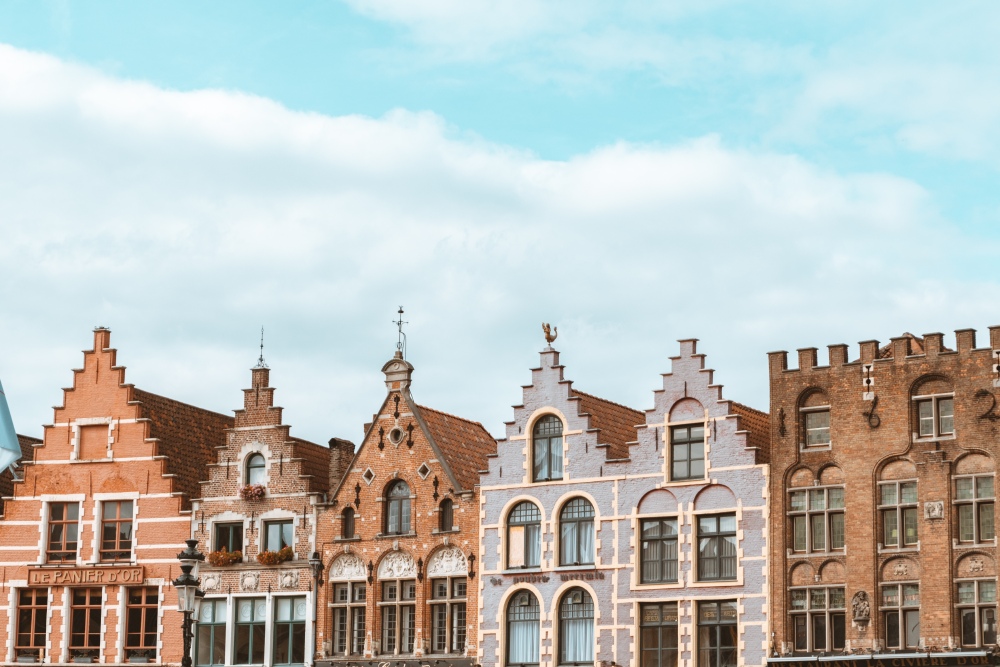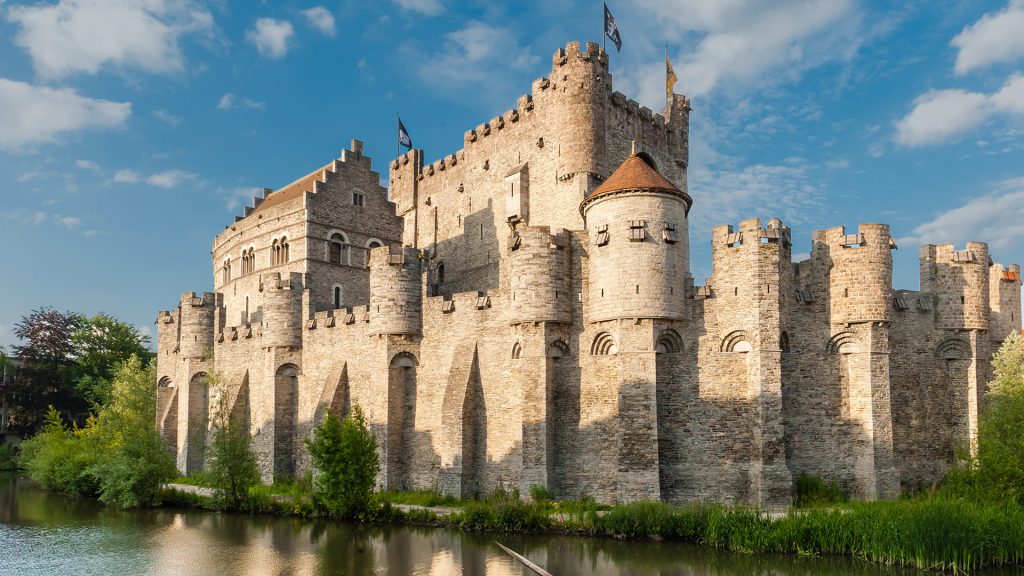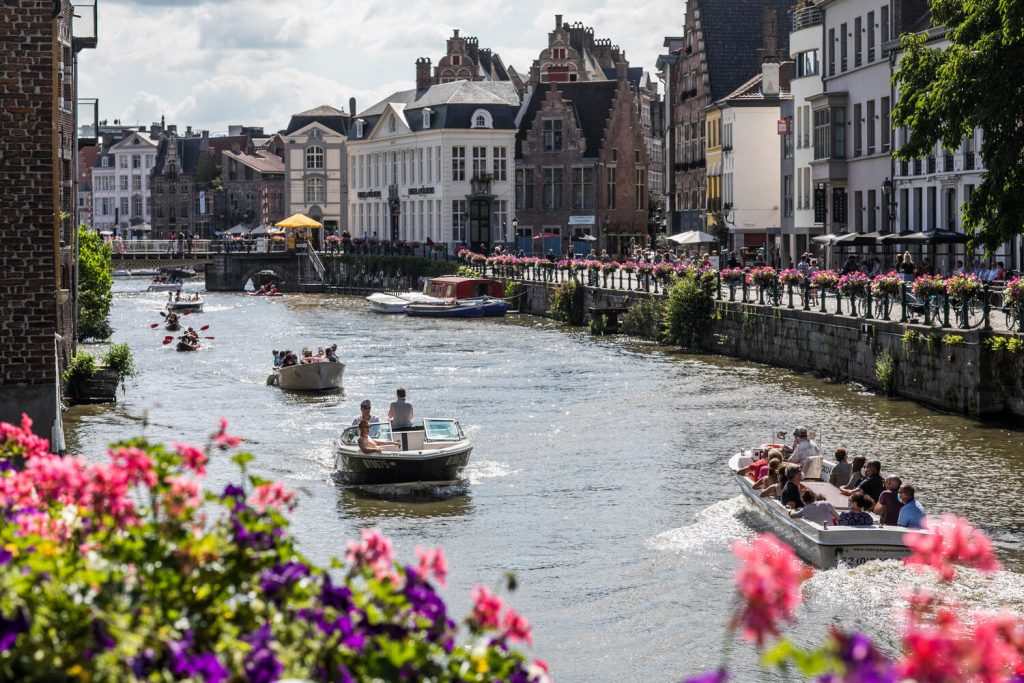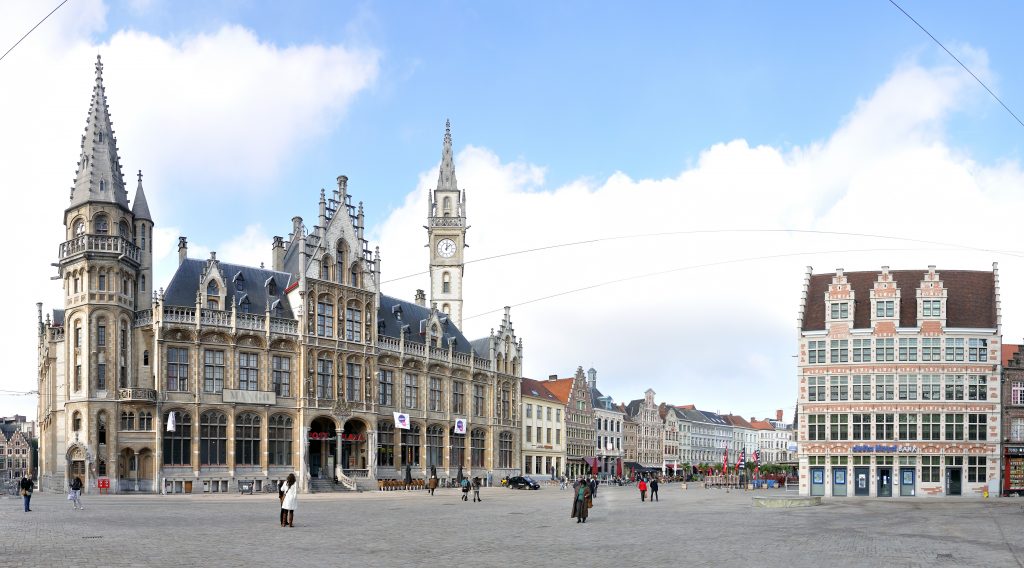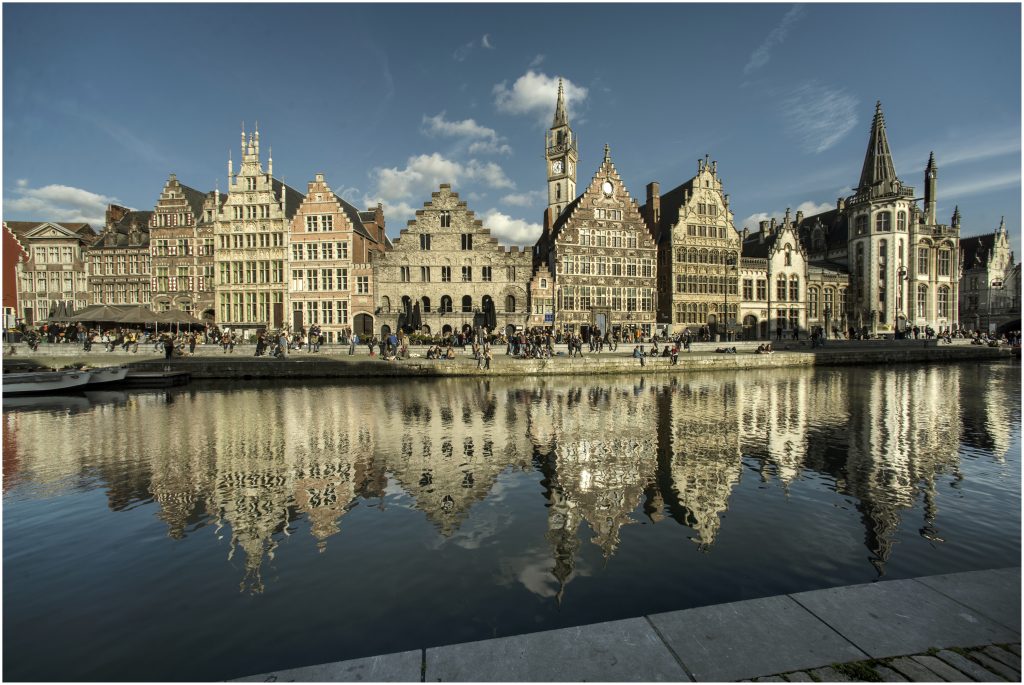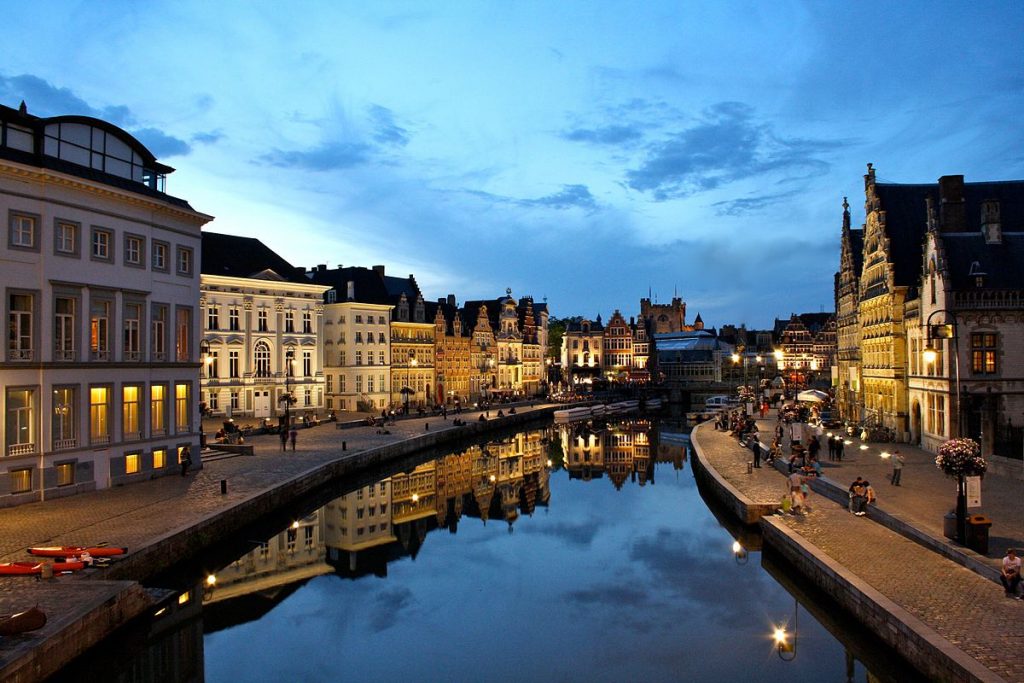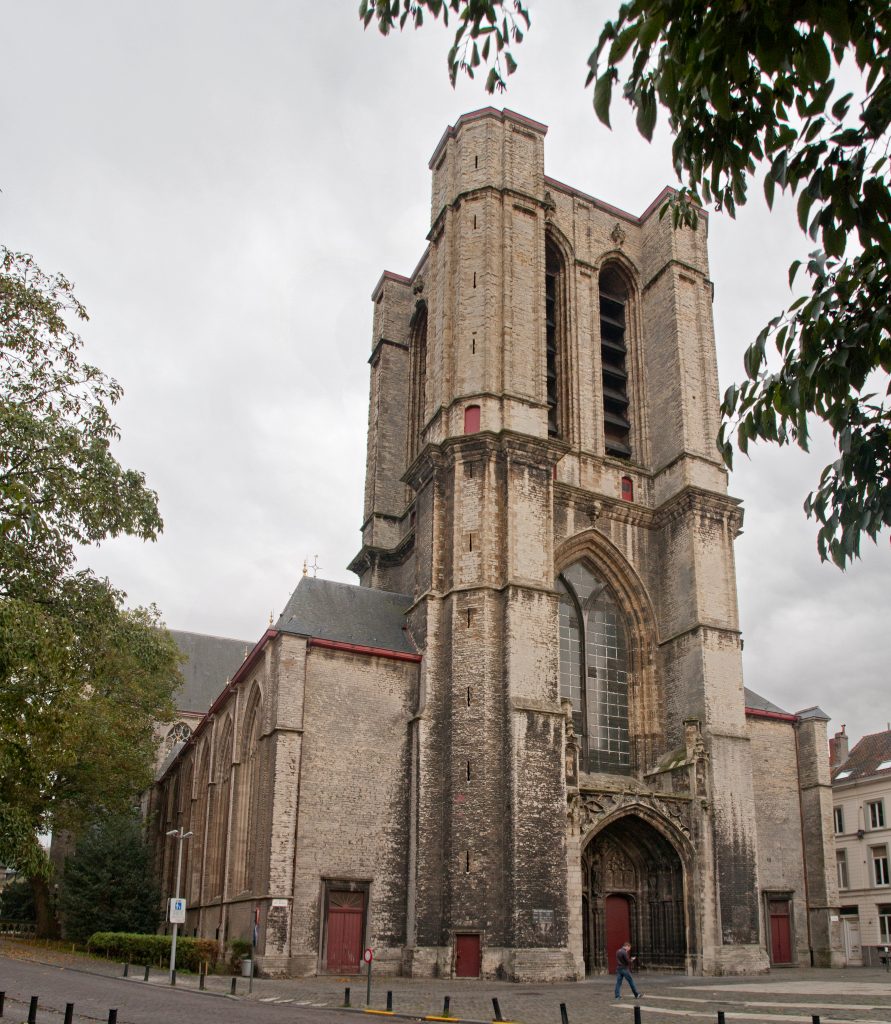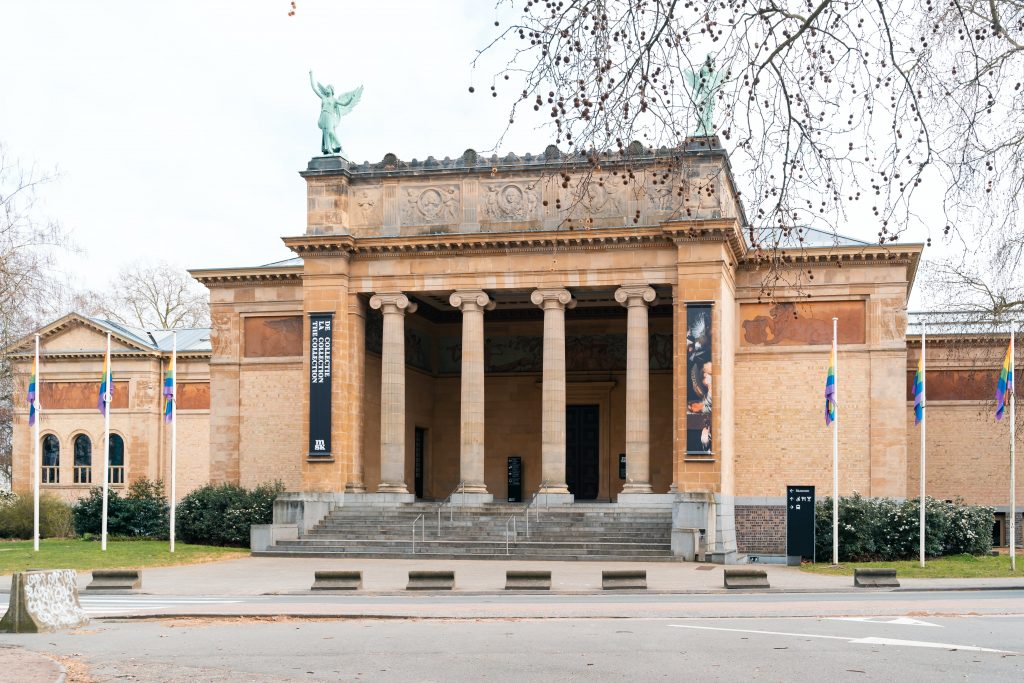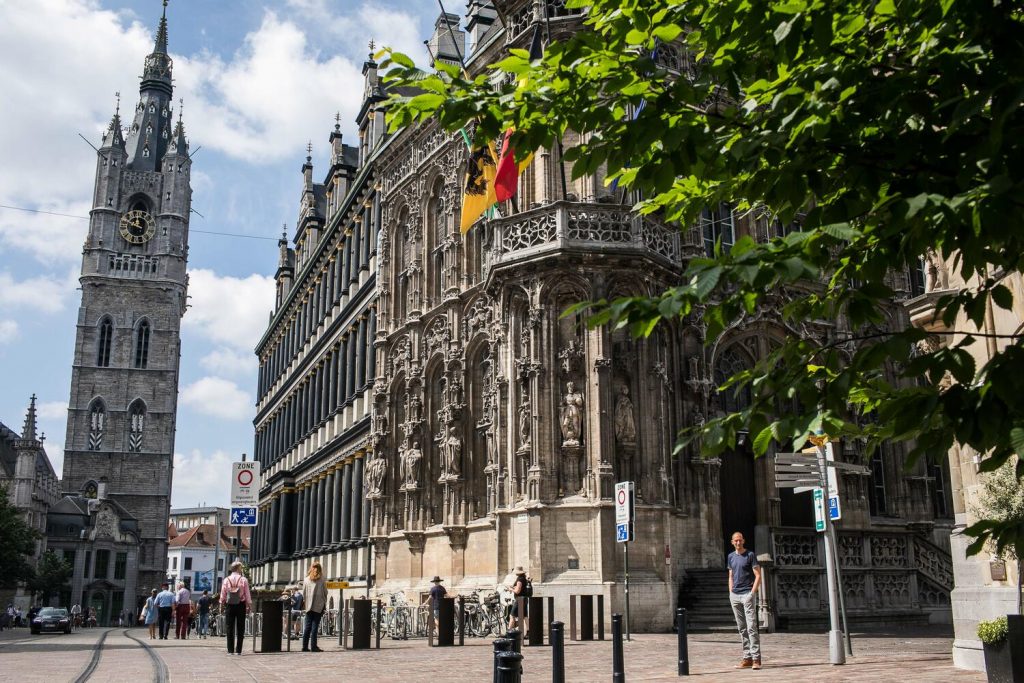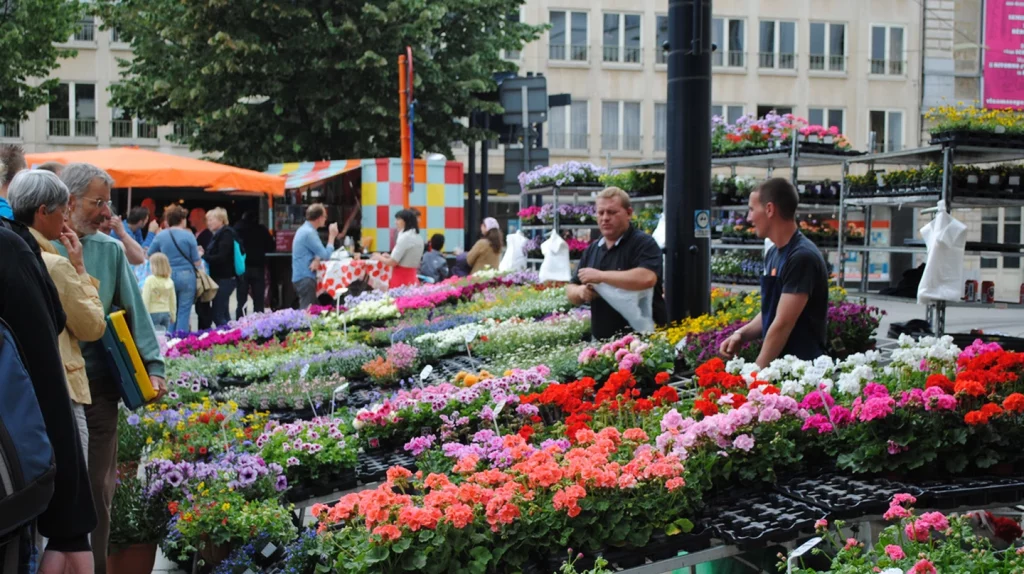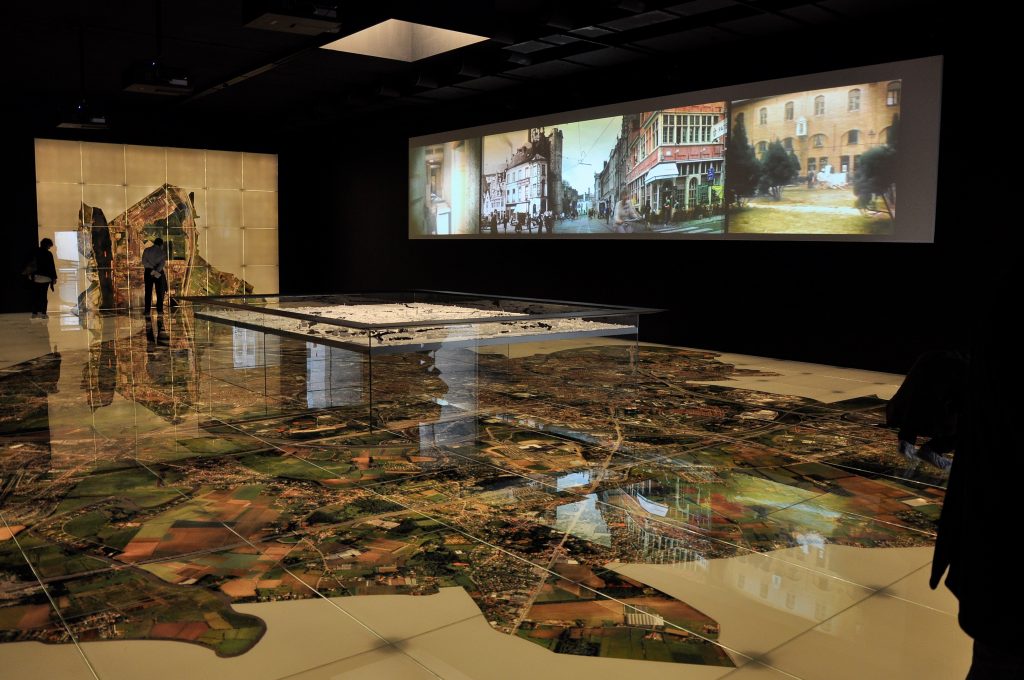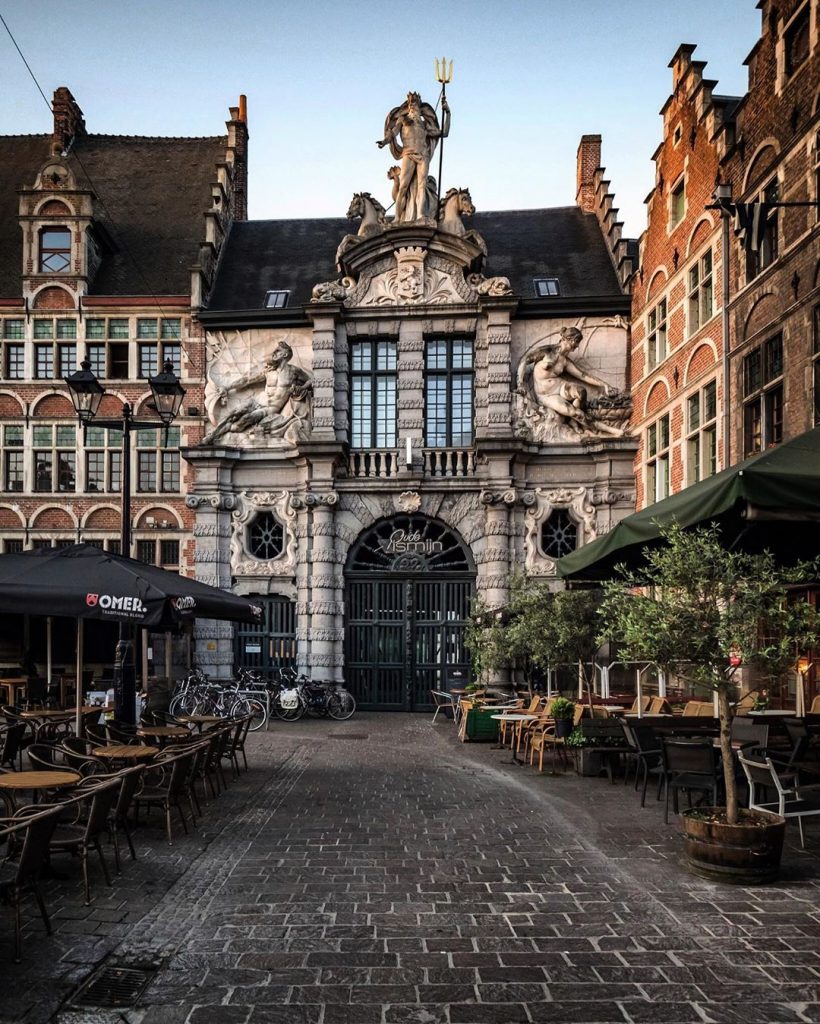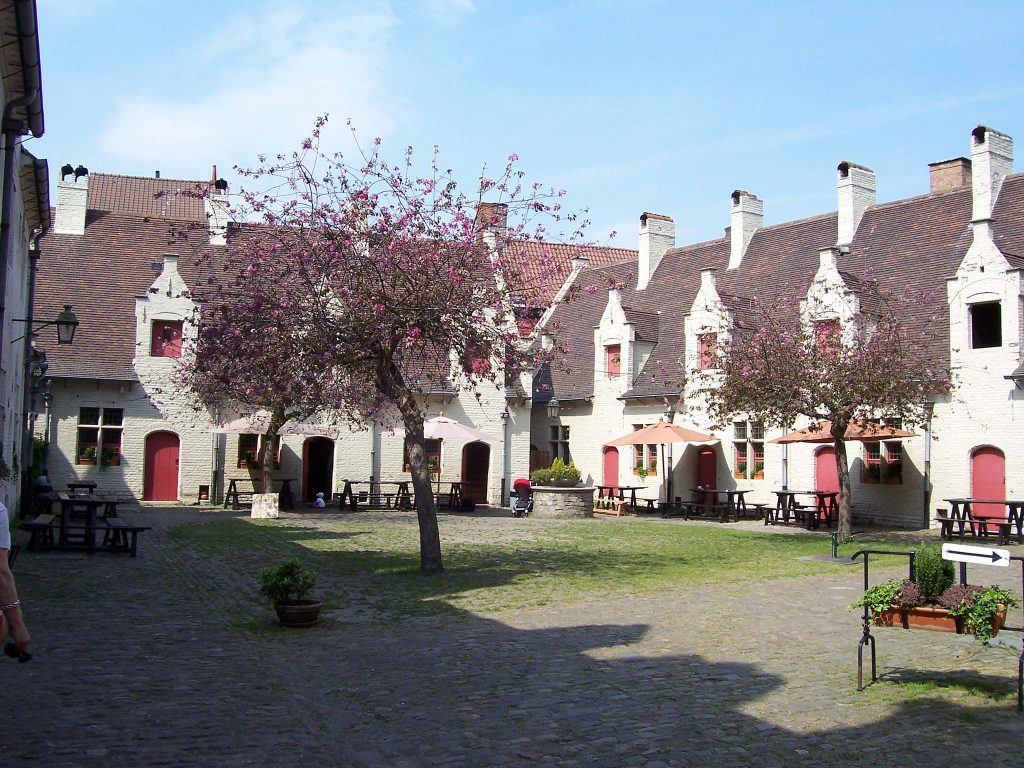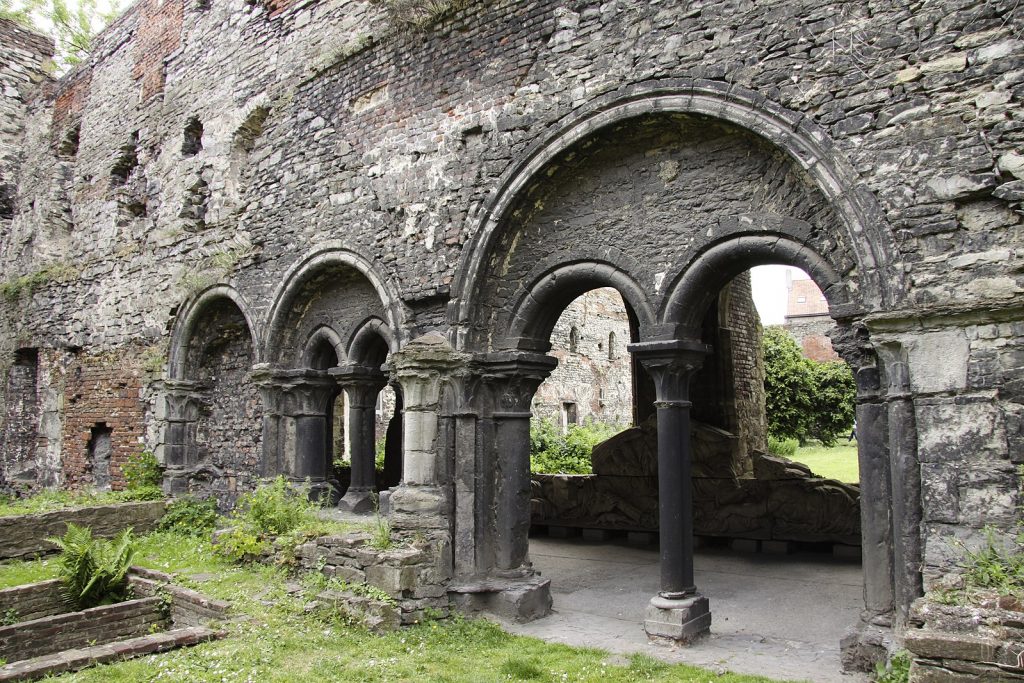Ghent is a beautiful city in the Flemish region of Belgium. This charming town offers something for everyone, from historical attractions to cultural events and activities. Whether you’re looking for a fun day of sightseeing or a relaxing weekend away, there’s plenty to explore in Ghent.
In this blog post, we’ll highlight the top 15 attractions and things to do in Ghent, so you can make the most of your time in the city. From iconic landmarks to hidden gems, you won’t want to miss any incredible sights and experiences Ghent offers.
✅ Make sure you’ll see the entire collection in Framey App, including addresses, opening hours, and contact information!
1) Gravensteen (The Castle of the Counts) – Attractions and Things to Do in Ghent
If you’re looking for a dose of history in Ghent, a visit to Gravensteen is a must. This impressive castle is one of the most well-preserved examples of medieval fortification in all of Europe. Built between 1180 and 1200 on the orders of Philip of Alsace, the castle was designed in the style of Syrian crusader castles, making it a unique attraction in the region.
The castle served as the administrative center for the Counts of Flanders until the 14th century when it ceased to have a military function. During this time, it was also used as a marketplace and the site of some gruesome events, including executions and the burning of victims of the Inquisition.
After being converted into a cotton mill and flats for workers in the 1800s, the castle was eventually restored and opened to the public as a museum in 1907. Today, visitors can tour most of the castle’s area, including the ramparts, and learn about the history of the site and its importance to the region.
Don’t forget to take in the view of the ancient Sint-Veerleplein, which sits in front of the castle and is possibly the oldest square in Ghent. While the neighboring facades are of 17th-century origin at the earliest, the square was once a marketplace and the site of some significant events throughout history.
Address: Sint-Veerleplein 11, Ghent.
2) Saint Bavo’s Cathedral (Sint-Baafskathedraal)
On the eastern side of Sint-Baafsplein stands the majestic Saint Bavo’s Cathedral, a remarkable brick and granite structure that boasts a Romanesque crypt of its predecessor, Sint-Jans church. Charles V, a Holy Roman Emperor, renamed the cathedral after he demolished the old one to construct a fortress.
Dating back to the 13th century, the High Gothic choir is one of the cathedral’s most notable features. The late Gothic tower and the primary nave were built during the 15th and 16th centuries. The light interior of the cathedral is richly decorated with several unique paintings. These include The Conversion of St. Baaf by Peter Paul Rubens (1624) and Christ among the Doctors by Frans Pourbus (1571).
The Altar of Ghent is the most famous artwork housed in the cathedral, also known as The Adoration of the Mystic Lamb, and is renowned as the greatest masterpiece of old Flemish painting. It is an exquisite piece of artwork that will leave visitors in awe.
Visitors to the cathedral should not miss the opportunity to explore the extensive crypt located below the main church. It contains numerous tombs of bishops and a rich treasury. The Calvary triptych of 1464 by Joos van Wassenhove (Justus van Gent) is also displayed in one of the chapels and is worth checking out.
If you’re planning a visit to Ghent, be sure to add the Cathedral of St. Bavo to your list of attractions. Its address is Sint-Baafsplein, located in central Ghent.
3) Cruise Ghent’s Canals – Attractions and Things to Do in Ghent
One of the best ways to experience Ghent’s beauty is by cruising through its picturesque canals. It’s an attraction by itself and provides the most relaxing sightseeing experience in the city. Ghent has several waterways, and each one has something unique to offer.
There are various ways to enjoy Ghent from the canals, ranging from regular public boat tours and private customizable cruises in a traditional tow-barge to kayak rental. Public boat tours are an affordable and easy option for sightseeing. Several different companies run regular public cruise departures from docks in the central city. The typical boat tour lasts 40 minutes and cruises past all of Ghent’s major sights, including the belfry and Gravensteen, as well as the canal-side guildhall architecture along the Leie canal.
On public tours, you can turn up and buy your ticket before you board, but if you want to reserve your ticket, check out the “Guided Boat Trip in Ghent.” This 40-minute boat cruise along the River Leie in Ghent lets you travel by open or covered boat and see the sights from the water. Admire the Grassley, the Castle of Counts, and the Groot Vleeshuis on this incredible tour. The boat cruises offer several departures throughout the day, so you can easily choose the time that works best for you.
Private customizable cruises, on the other hand, offer the flexibility to tailor your experience to your interests and schedule.
If you’re feeling adventurous, consider renting a kayak and paddling your way through the waterways of Ghent. Kayaking allows you to enjoy the city from a different perspective and take your time to explore the hidden corners of Ghent.
4) Climb to the Top of The Belfry (Het Belfort)
If you want to see the breathtaking views of Ghent’s central old town district, you need to climb to the top of The Belfry. Standing at 91 meters high, this tower is an emblem of the city’s independence. It was constructed around 1300 and mostly completed by 1338, and its present-day spire was restored to its original 14th-century form at the beginning of this century.
Crowned by a gilded copper dragon, which was installed in 1377 and is now a replica, the tower has four armed figures at the corners of the platform, which are replicas except for one original figure that can be seen on the ground floor. The charters of the privileges of Ghent were kept in this tower.
You can either take the elevator from the first floor or climb up to the top of the tower. Upon reaching the top, the stunning panoramic views of the city are worth the climb. Additionally, you’ll get an up-close view of the four replicas of the original figures and the gold dragon, which is symbolic of Ghent’s independence.
The Belfry is situated on the west side of Sint-Baafsplein and directly adjacent to the Cloth Hall, which was constructed between 1426-1441 and converted into a prison in the 18th century.
Don’t miss the chance to climb to the top of The Belfry for awe-inspiring views and an unforgettable experience while visiting Ghent.
The Belfry and Cloth Hall are located at Sint-Baafsplein in Central Ghent.
5) Explore Korenmarkt – Attractions and Things to Do in Ghent
If you’re looking for a bustling, lively square with plenty of character, then Ghent’s Korenmarkt is the perfect destination. This historic square was once the hub of trade in the city and is now known for its stunning architecture and excellent dining options.
As you walk along the Leie Canal, you’ll notice the numerous old Guild Houses that line the Korenmarkt, adding to the charm and character of the area. Many of these buildings have been restored to their former glory and now house an array of shops, restaurants, and cafes.
One of the most notable landmarks on the southern side of the Korenmarkt is St. Nicholas Church, constructed in the Scheldt Gothic style using Tournai bluestone in the 13th century. The central tower is especially imposing and offers a fantastic photo opportunity.
In late July, the Korenmarkt comes alive with the Gense Fieste festival, a 10-day celebration featuring music, theater, entertainment, and a multitude of food stalls. This is the perfect opportunity to immerse yourself in Ghent’s culture and join the locals in a celebration of their city’s rich history and traditions.
In summary, the Korenmarkt is a must-visit destination when exploring Ghent. Its vibrant atmosphere, stunning architecture, and delicious dining options make it the perfect place to immerse yourself in the city’s culture and enjoy the local way of life.
6) Neighborhood of Graslei
The Neighborhood of Graslei is a must-visit destination for architecture enthusiasts. The canal is home to some of Belgium’s most exceptional guild houses, and it’s a perfect spot for a leisurely stroll.
One of the notable buildings is the Gildehuis der Vrije Schippers, also known as the House of the Free Boatmen, built-in 1531 in the Brabant Gothic style. The House of the Grain Weighers or the Gildehuis der Graanmeters, with its elegant stepped gable from 1698, is another outstanding structure in the area.
As you wander further down the canal, you’ll spot the Flemish Renaissance Customs House or Tolhuisje built in 1682. The Romanesque Spijker or Koornstapelhuis dating back to around 1200 is also situated nearby. Finally, the Gildehuis der Metselaars, or the House of the Masons is a Brabant Gothic-style building that completes the row of unique guild houses.
Visiting the Neighborhood of Graslei is an excellent opportunity to witness the exquisite architecture of these historical structures that continue to stand tall. So, don’t forget to include it in your itinerary while exploring Ghent, Belgium.
7) Be Amazed by Korenlei Canal Area – Attractions and Things to Do in Ghent
As you stroll down the Sint-Michielsbrug and gaze out over the picturesque Korenlei Canal, you’ll be struck by the stunning architecture that lines its banks. The facades of the houses here are simply magnificent and provide some of the best views of the even grander buildings on the other side of the Graslei.
Make sure to take note of some of the notable buildings along the way. For instance, No. 15 used to be the Hof van Gruuthuse, also known as the House of Duke Egmont. Dating back to 1352, the building has since been replaced by a structure with a beautiful Neoclassical facade, which also encompasses No. 17-19, the Hotel de Ghellinck.
Further down, No. 7 houses the Gildehuis der Onvrije Schippers or the House of the Tied Boatmen. The Baroque building was constructed in 1739 and stands as a testament to the city’s maritime heritage.
And be sure to keep your eyes peeled for No. 24, Lintworm en Krocht, whose Romanesque castle was rebuilt in the early 20th century. The stunning façade of this building is a true work of art.
All in all, a stroll through the Korenlei Canal Area is an absolute must-do when visiting Ghent.
Address: Korenlei, central Ghent.
8) Saint Michael’s Church and Sint-Michielsbrug
One of the most impressive churches in Ghent is Saint Michael’s Church. Located on the western shore of the Leie, this massive Gothic church is constructed of Belgian sandstone and is a true marvel of architecture. The church’s grandeur is simply breathtaking, and its interior is equally impressive, with the pulpit, altar, and many other parts of the church featuring Neo-Gothic style.
As you explore the church, you’ll discover a wide range of art styles, including an early 17th-century Baroque confessional.
Saint Michael’s Church is also home to several 18th-century statues, paintings by Baroque artists like van Dyck, and the Relic of Doorn, which was a gift from Mary Queen of Scots. It’s no wonder this church is considered one of the most important religious sites in Ghent.
Next to the church, you’ll find Sint-Michielsbrug (Saint Michael’s Bridge). This stunning stone-arch bridge offers an unparalleled view of Ghent’s skyline. From here, you can see all three of the city’s iconic towers, including the Belfry, Saint Nicholas’ Church, and Saint Bavo’s Cathedral.
For the best views, visit Sint-Michielsbrug in the evening when the city’s landmarks are illuminated. This makes for an excellent photo opportunity and is a great way to experience the city’s beauty after dark.
Don’t miss the chance to explore Saint Michael’s Church and Sint-Michielsbrug when you visit Ghent. They’re both incredible sights that are sure to leave a lasting impression on your visit to this charming Belgian city. You can find the church and bridge at Sint-Michielsplein 4, 9000 Ghent.
9) The Museum of Fine Arts (Museum voor Schone Kunsten) – Attractions and Things to Do in Ghent
If you’re a lover of fine arts, the Museum of Fine Arts (Museum voor Schone Kunsten) in Ghent is worth visiting. The museum has a diverse collection of paintings covering the 15th to 20th centuries, with the emphasis being on painting. As soon as you enter, you’ll be greeted by the central hall that has eight Brussels wall tapestries with three motifs from the story of Darius (17th century) and five with the theme “Triumph of the Gods” (1717). It’s an impressive sight to see these fine tapestries hanging on the walls.
If you’re into Old Masters, then you won’t be disappointed either. To the left of the Tapestry Room are paintings of the Old Masters, with Hieronymus Bosch’s two works in Room B – Bearing of the Cross and St. Hieronymus – being prominent. The museum also houses a great collection of paintings from the 19th and 20th centuries, especially by Belgian artists.
Apart from its permanent collection, the museum also hosts traveling exhibits from other world-class fine arts museums, which makes it worth visiting again and again.
If you’re planning a visit, note that the Museum of Fine Art is located at Fernand Scribedreef 1, Liemaeckereplein, Ghent. The museum is open from Monday to Sunday from 10 am to 5 pm, except Thursday, when it stays open until 10 pm. On Saturdays and Sundays, the museum closes at 6 pm.
Overall, the Museum of Fine Arts (Museum voor Schone Kunsten) in Ghent is a must-visit for art lovers. From tapestries to paintings of Old Masters and contemporary artists, this museum has it all.
10) City Hall (Stadhuis)
Ghent’s town hall is a must-see attraction for visitors to the city. Built over a long period, this magnificent building combines a variety of architectural styles, making it a fascinating sight to behold. The oldest parts of the building, which date back to 1482 and contain the council chambers, were completed in the style of Bruges City Hall. The wing built by architects Rombout Keldermans and Dominic de Waghemakere is a fine example of late Gothic style and is richly decorated with statues.
However, building work on this part of the building was suspended in 1539 due to religious disputes, and only a quarter of the original plan was realized. The Peace Hall and Marriage Chapel, both completed in 1535, are the only parts of this wing that were built. Work only resumed on the building at the end of the 16th century, resulting in the wing facing the Botermarkt being built in Renaissance style, including the Throne Room on the upper floor.
Visitors to the town hall will be in awe of the stunning architecture, as well as the fascinating history behind this magnificent building.
The town hall is located on Botermarkt, in the heart of central Ghent, making it a convenient stop on any tour of the city. Don’t miss out on the opportunity to visit one of the most impressive landmarks in Ghent.
11) Visit the Old Market Area – Attractions and Things to Do in Ghent
One of the must-see attractions in Ghent is the Old Market or Groentenmarkt. This historic market dates back to medieval times when it served as a fish market and later transitioned into a vegetable market in the 18th century. Visitors can still see the remnants of Ghent’s pillory which stood in this market during medieval times.
On the west side of the market, visitors will find the impressive Groot Vleeshuis, a medieval covered meat market with a guild house, chapel, and numerous gables on the roof. The building dates back to the early 15th century and was restored in 1912. The Groot Vleeshuis offers a glimpse into Ghent’s rich history and architecture.
At the south end of the Vleeshuis is the Penshuizeken, also known as the “entrails cottage.” In the past, this cottage provided entrails of slaughtered animals to the poor. Today, the Vleeshuis building has been converted into a fine restaurant, but visitors can still appreciate its impressive architecture by walking through the interior.
If you’re looking for a unique way to explore the Old Market area, be sure to visit on a Friday morning when the weekly market takes place. Here, visitors can browse the stalls for fresh produce, flowers, and handmade crafts.
Address: Groentenmarkt, Hoogpoort, central Ghent.
12) Ghent City Museum (STAM)
The Museum of Ghent, also known as the Ghent City Museum or STAM, is a must-visit attraction for history buffs and culture enthusiasts. Housed in the beautiful brick buildings of the Cistercian Abbey of Bijloke, this museum is one of the richest in Belgium and features an impressive collection that tells the story of Ghent’s heritage and culture in a unique historical setting.
The museum’s numerous rooms are arranged chronologically, taking visitors on a journey through Ghent’s rich history. You can marvel at an extensive collection of exhibits, including jewelry, weapons, textiles, books, paintings, religious icons, and ceramics, all presented engagingly with state-of-the-art multimedia displays.
The center point of the museum is the 14th-century refectory, which boasts an exceptional brick gable and is home to a 10-meter-long painting of the Last Supper. The interior walls are painted with frescoes, adding to the already breathtaking setting of the museum.
Aside from the permanent collection, STAM also hosts a series of temporary exhibits throughout the year that are housed in the neighboring monastery building. So, even if you’ve been to the museum before, there’s always something new to discover and appreciate.
You can find the Ghent City Museum at Godshuizenlaan 2. It’s open on Monday, Tuesday, Thursday, and Friday from 9 am to 5 pm, and on Saturday and Sunday from 10 am to 6 pm. The museum is closed on Wednesdays.
Overall, the Museum of Ghent is a top attraction in the city and should not be missed. With its remarkable collection and outstanding historical setting, this museum will impress and enlighten visitors of all ages and interests.
13) The Architecture of Vismarkt and Kraanlei – Attractions and Things to Do in Ghent
As you stroll through Ghent, you’ll notice that the city’s architecture is truly awe-inspiring, and the buildings at Vismarkt and Kraanlei are no exception. These two areas are known for their superb Baroque buildings, elegant houses, and intricate allegorical reliefs.
At Sint-Veerleplein No. 5, you’ll find the old fish market, which was built in 1689 by Artus Quellin. The Baroque-style building features a gateway adorned with depictions of Neptune and allegorical representations of the Scheldt and Leie rivers.
Just northeast of the fish market, the Kraanlei Canal runs parallel to Sint-Veerleplein and is lined with a row of elegant houses. Among these, No. 1 is Craenenburgh, and Nos. 3-11 are known as De Lelye. These houses were built around 1500 in the Brabant Gothic style, and they offer a glimpse into Ghent’s rich architectural heritage.
As you walk along the Kraanlei, be sure to admire house No. 75, De Klok, which dates back to the 17th century and is decorated with numerous allegorical reliefs. No. 77, De Zeven Werken van Barmhartigheid, and No. 79, Het Vliegend Hert, are also Baroque-style townhouses from the same era, boasting exquisite reliefs that are a true feast for the eyes.
The architecture of Vismarkt and Kraanlei is truly a testament to Ghent’s rich history and cultural heritage.
14) The Folklore Museum (Museum voor Volkskunde)
If you are looking for a museum that offers a unique glimpse into the lives of Flemish people during the early 1900s, then the The Folklore Museum is the perfect place for you. Located at Kraanlei 65 in Ghent, this museum is housed in 18 interconnecting Flemish cottages that were founded in 1363 as a children’s hospital. These houses were set up by wealthy families to help those in need, and they are now one of the last remaining Godshuizen in Belgium.
The museum was immaculately restored in 1962, and it boasts an impressive collection of equipment, documents, and everyday objects that provide a vivid picture of Flemish folk life around 1900. As you explore the museum, you’ll come across some restored workshops and living rooms that will transport you back in time. These include a dining room, a barber’s shop, a cobbler’s workshop, an apothecary’s shop, a confectioner’s bakery, and a candlestick maker’s workshop.
One of the most picturesque areas of the Museum voor Volkskunde is its courtyard, which is home to the 18 typical Flemish cottages. Here, you can appreciate the unique architecture of the buildings and imagine what life was like for those who lived in them centuries ago.
Check its opening times
If you plan to visit the Museum voor Volkskunde, be sure to check its opening times. It is closed on Mondays, but open from 10 am to 5 pm on Tuesdays, Wednesdays, Fridays, Saturdays, and Sundays. On Thursdays, it stays open until 8 pm, so this might be the perfect time to explore the museum and take in all of its fascinating exhibits.
All in all, if you’re interested in history and culture, then a visit to the The Folklore Museum in Ghent is a must. This museum offers a unique perspective on Flemish life from the past, and it’s a great way to spend a few hours visiting this beautiful Belgian city.
15) Walk through the Ruins of Sint-Baafsabdij – Attractions and Things to Do in Ghent
If you are interested in history, architecture, or art, the ruins of Sint-Baafsabdij are a must-visit site in Ghent. This ancient abbey was founded in 630 AD by St. Amandus and has a rich history that spans centuries.
To get to the ruins, you’ll need to cross the Slachthuisbrug over the Leie Canal in the eastern part of the city. Once you arrive, you’ll see the remnants of the abbey that was destroyed by the Normans in the 10th century. The Gothic cloisters are stunning and the octagonal lavatorium is something to behold.
Although much of the original abbey is now in ruins, parts of the chapter house and the refectory are still standing. The refectory is particularly noteworthy, as it houses the Museum voor Stenen Voorwerpen (Museum for Stone Cutting and Sculpture). The refectory also features incredible 12th-century Romanesque frescoes that are simply stunning.
In the museum, you’ll find an impressive collection of medieval tombstones, Ghent sculptures, and architectural artifacts from the 12th to the 18th centuries. The mosaics on display are particularly impressive and provide a glimpse into the abbey’s rich past.
If you’re looking for a peaceful escape from the bustling city, a walk through the ruins of Sint-Baafsabdij is a perfect choice. The address of this must-see attraction is Godshuizenlaan 2, Ghent.
Check out Framey!
We hope that our top 15 attractions and things to do in Ghent, Belgium have inspired you to book your next trip to this beautiful city. Make sure to download Framey App to capture all the memorable moments of your trip and share them with your friends around the world.
Don’t forget to indulge in the local delicacies and soak up the vibrant atmosphere of the city.
Happy travels!
Also read: Things To Do in Europe: Top 10 Experiences for a Once-In-A-Lifetime Adventure


